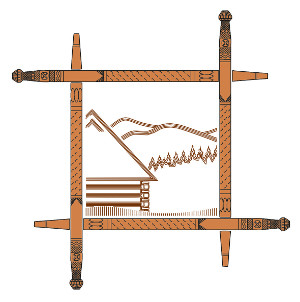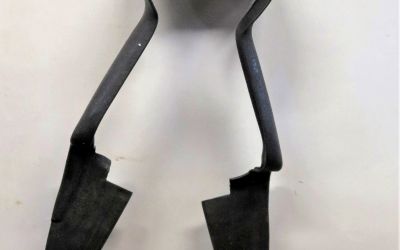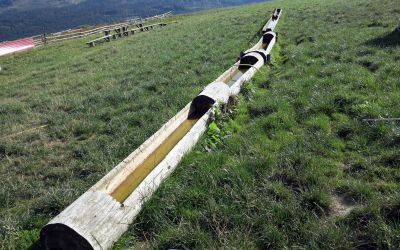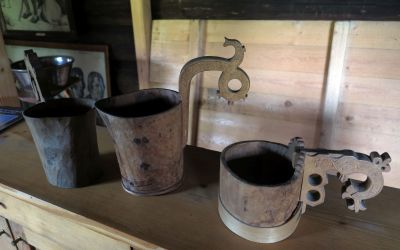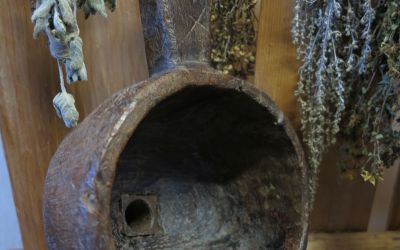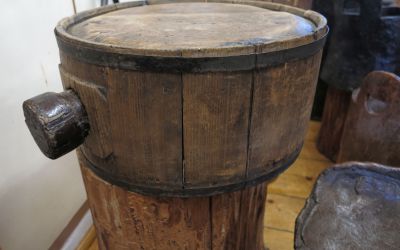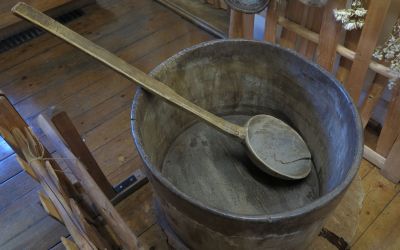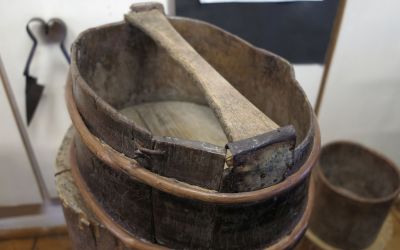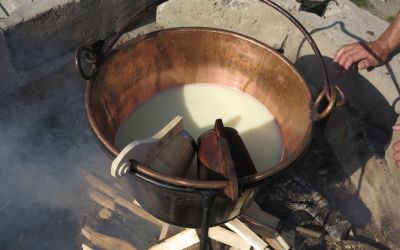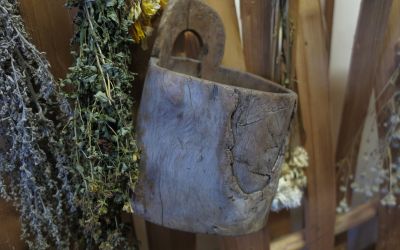
Sałasz consisted of a room where in the middle or in the corner, right next to the entrance, there was a hearth with constantly burning fire. Above the Watt, the Jadwiga was most often attached to the roof rafter - a wooden hook, usually self-made. Depending on the construction, the walls of the butt were equipped with police shelves, which were filled with equipment and utensils. Opposite the watter was a fly, a cougar-shelf on which cheese was stored.
The items needed for the daily rite were collected on sashash. They were mostly picked out of stump trunks, or decayed trees, mosor dishes, first of all scoops - wooden cups turned from a single piece of tree, with or without a handle. Among the basic stave dishes should be distinguished gielnym (Romanian) wooden stave dish. Narrower at the top with a cross grip. It was used for milking and carrying water. Flat cladding, low stave keg for transporting or transporting creep with a hole on the side. Poplar or linden was used for cutter. Water troughs for sheep were made of fir. Milk was boiled in a cast-iron boiler hung on Jadwiga. After the first milking of the sheep, the milk was strained on a canvas with three fir branches. This treatment was to protect sheep against disease and protect milk against deterioration. Near the hut there was a sheep milking parlor called a trout. Baca dealt with the production of cheese, and three days after the arrival of the sheep at the hall, a trial milking took place and a contract was concluded with the gazda regarding the amount of cheese due to them, called myrrh. They usually went with the Juhas to graze sheep, and at noon they returned their own milking when they returned. After milking, everyone stuck a thin stick into the dish and notched where the milk was. By this measure, the second stick meant and such mirek gave shepherds. All milk from this milking was measured by zamirką; one stayed with the shepherd and the other part with the gazda. According to this measurement, shepherd's cheese was to be weighed. Sheep grazing in the halls gave from mid-May to mid-September from 30 to 60 liters of milk, from which 6 to 12 kg of bundz were made. Sheep was milked at first three times a day, then two.
The most important person in Sasha was a shepherd of Romanian origin. In the Silesian Beskids, it is referred to as the cap, sałasznik , head of economy, experienced sheepdog, co- tenant of the hall, glades. He performed his function during grazing from spring to the first snows. It had to be a trustworthy person, otherwise the Gazds would not give him their sheep or let them graze on their land. His tasks also included arranging shepherds to work. The shepherd, due to basic medical knowledge and knowledge of medicinal properties of herbs, enjoyed respect in the local community. Baca was involved in quackery, dentistry, compilation of broken bones, so he had secret knowledge. In the village, he was treated like a blacksmith, aroused fear and respect. Important artifacts for performing magic treatments include the herbs were collected in a chest. He also stored essential herbs among many important equipment. Shepherd collected herbs he needed from the herb , during important church holidays. In St. Błażej blessed the water in the church, which he added to bake pancakes from it. the mosques then gave them to sheep who were sick as a result of their charm. Effective against various types of spells, ash was collected on Ash Wednesday. An important day was for the shepherd - August 15, the Mother of God. Then everyone shone what they did and needed. It was believed that the herbs consecrated on that day have special potency. Poisonous herbs prevented diseases, but medicinal ones were added to the feed to keep the sheep healthy. The chief shepherd himself performed most of the magical activities. Magic treatments were particularly important when shepherds arrived for the first time after Sacha . Before the repair work began, several rituals had to be carried out, such as sprinkling shepherd's head with salted water. All magic was done with due seriousness and reverence. He began with a sign with a cross and a prayer. Then a watre was put in and the fire was asked not to go out during the grazing. Later, the cob was incensed, and the remains of herbs and incense were buried under the barracks . A baker ( Orawa, Żywieckie) - a person dealing in castration of animals - met in the service of Sashash . Called the repairman, a sorcerer with supernatural power, he could, for example, conjure up milk. His female counterpart is the repair woman in the Silesian and Żywiec Beskids.
Young boys - touts came to help reprimanding sheep. Grazing flocks of sheep called for neighboring halls. The echo carrying their voice was called helokanie . The equipment that facilitated their work were all sorts of sticks, sticks that were used to rush and support. The pastoral stick used to catch the sheep was characteristic. Bells and jaws protected the sheep from charms and facilitated the location of the sheep, which moved away from the kyrdel, the herd. An important moment was the sheep shearing taking place once or twice a year depending on the purpose of the obtained fleece. All people who were in SALAHA were involved in this type of work. The most convenient time for hair cutting was the new moon period, when the wool grew faster.
Among the animals found in Sałash were sheep, a small number of goats and guarding dogs . The sheep breeds came from a large group called the "sheep" found for centuries in the Southern Carpathians and parts of the Balkans. Sheep have a mixed wool coat, resistant to harsh meteorological conditions. The sheep coat consists of down and spinal hair. Most often sheep of this breed are identified with the Polish mountain sheep. It came to the area of the Polish Carpathians along with the white variety during the movement of Wallachian-Ruthenian shepherd tribes along the Carpathian chain. These walks lasted from the fourteenth century and ended at the Moravian Gate in the sixteenth century. After the last world war, together with the commencement of work on improving the white variety of the sheep, the Polish mountain sheep (aka mountain sheep) was adopted in Poland for this group. An inseparable helper of the man who served as the protector of the herd was the dog.
Quadruped breeds suitable for working with sheep and herding herds are mainly shepherds and collies. The most important feature of the shepherd dog was to gain a dominant position in the herd and gently bite the sheep so as not to hurt them.
Cheese and meat are the main effect of pastoral economy. Rye-milk whey from sheep's milk, excellent when heated, left in the broth, quenching thirst on hot days. The nutritional value of sheep's milk is attributed to the medicinal plant species used in folk medicine to grow in halls and pastures. In folk medicine, whey has long been valued, among others, as a medicine for stomach problems or for skin care, while farmers gave it to cattle as a valuable protein feed. The townspeople also became interested in it, who in time began to come, including to Ustroń in order to take a life cure . Bundz is a traditional rennet cheese. Klaganego produced from milk. It has a delicate taste, similar to cottage cheese in consistency. Sweet fresh bundz from spring grazing tastes best. Redykołka is a smaller oscypek, made from milk residue. Its name is associated with the market where shepherds treated local people with these cheese. They can be found throughout the entire arch of the Carpathians. Oscypek, this cheese was already made by Wallachians centuries ago. From 2008 is registered as Protected Name. It can be produced only in: Istebna, Milówka, Węgierska Górka, Rajcza, Jeleśnia, and Koszarawa. Oscypek has a characteristic shiny-yellow color. It is produced during the entire grazing season from bundz. Korbacze are long threads woven into bundles, serving as an appetizer. Gołka is made from cow's milk. Served as a replacement for sheep's cheese.




